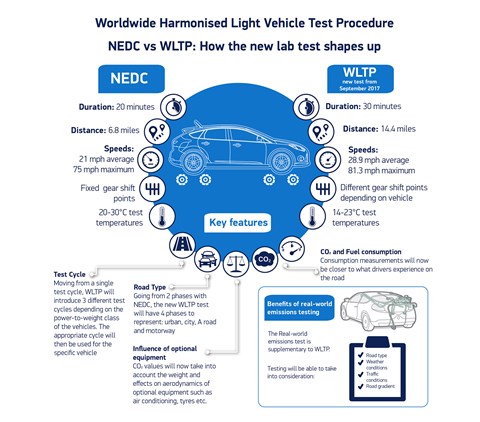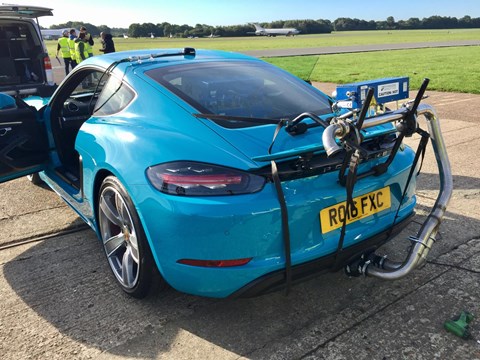► New WLTP tests explained
► Europe’s new fuel economy regs
► Important for EVs too
If you’re looking at buying a conventional car or an EV, you’ll have come across the new WLTP standard. The new standard came into force on 1 September 2017, replacing the earlier – and largely discredited – NEDC regulations which led to misleading advertising claims. It’s a staggered roll-out: from 1 September 2018, only WLTP-homologated cars could be sold in Europe.
WLTP is one of the most tangible changes since the VW emissions scandal changed the legal and ethical landscape of fuel economy reporting – though the new test format was planned long before that, dating back to 2007. But can the new system work? Read on for CAR’s handy explainer.
Further motoring advice:
What does WLTP stand for?
WLTP is short for the snappily titled Worldwide Harmonised Light Vehicle Test Procedure and is the name for the EU’s new fuel efficiency ratings for all petrol, diesel, electric and hybrid cars.
Instead of relying on less realistic laboratory tests alone, the new procedure supplements lab rigs with additional real-world testing. Its creators claim these are the world’s first official fuel economy tests undertaken on the open road.

What is the new WLTP cycle?
The new tests measure fuel consumption, carbon dioxide (CO2) emissions, nitrogen oxides (NOX), carbon monoxide (CO) and particulates by mass and number (PM and PN). So far, so familiar. The big change is in the methodology.
Earlier NEDC economy tests have barely changed in 20 years, according to the Society of Motor Manufacturers and Traders. The New European Driving Cycle dates back to the 1980s and is widely criticised for being unrealistic.
Most cars on sale in Britain today miss their claimed combined fuel economy figures – the ones quoted by manufacturers in adverts – by a quarter or worse. The NEDC regs were last updated in 1997.
How will the new WLTP figures compare with old NEDC ones?
You can expect the new figures to tumble by around 20% in many cases – though like-for-like models will return the same real-world economy before and after.
‘The introduction of WLTP can be compared to a currency reform,’ Mercedes states in a review of the new testing regime. ‘Although the vehicles will not change technically, they will simply be measured by new standards.’
Drops of 13% to 18% in claimed economy were found by automotive industry data supplier JATO, which compared NEDC and WLTP figures for 18 models tested under both systems.
What about EVs and plug-in hybrid electric vehicles?
WLTP means a completely new way of testing PHEVs – cars that can fall furthest away from official figures, depending on how often you visit a plug.
Plug-in hybrids will have to do the test several times, starting with a full battery and repeating the test until the battery is empty. Another assessment will be carried out with a completely flat battery, to give a much more accurate idea of the economy real drivers can expect.
Finally the eco-boffins will do some serious calculator bashing to work out the official emissions and economy figures, scaled depending upon the car’s electric range.
You can find out the longest range electric cars, calculated using WLTP here.
Key dates, introduction and timings of the new economy regs
All brand new cars being homologated for launch must now meet the new WLTP rules, but there is a staggered roll-out. The WLTP laboratory element of the tests will have been conducted on all models on sale by 1 September 2018, while the on-road RDE testing element must have been completed by 1 September 2019.

From April 2020 it’s likely that the new figures will be the ones used for tax purposes and published in adverts. Following this, 2021 will see WLTP figures finally killing off their NEDC predecessors.
Why a two-year delay in launching the new regulations in full? Because of the enormous complexity of testing every make, model, bodystyle and derivative, complete with every accessory and optional extra. The new rules demand transparency on what effect, for example, fitting bigger alloy wheels will have on your CO2 and mpg.
The mind boggles at the difficulties manufacturers and their configurators now face…
Why should we trust the new fuel economy figures more?
On the one hand, WLTP testing is still measured in a lab. So what makes these tests more realistic? The EU argues the new measures include higher speeds, longer distances and more dynamic driving, with a greater spread of engine load, gears used and temperatures – to make it more like real-world driving.
Less pottering about like Aunt Doris and more Dash To The Shops like most of us.

Secondly, the new on-road element is real-world driving. The Real Driving Emissions (RDE) test will have monitoring gear strapped to a car’s exhuasts to measure the pollutants spewing out.
Portable Emissions Measurement System (PEMS), as seen above, will be used to monitor tailpipe emissions of nasties such as NOX and particulates – which must stay below a prescribed limit in real driving.
It’s not as simple as that though, is it?
No, it isn’t. The old NEDC mpg and CO2 figures will still be reported until 2020 – as these will continue to determine the European CO2 emission fleet average targets. The old NEDC system was used to set the targets, see.
And the UK will continue to use NEDC CO2 emission values to work out vehicle tax, in the short term at least. So your VED and BIK company car tax bills will continue to be calculated under the old rules.
All clear? Good. Sounds like a classic bureaucratic change with plenty of complexity for some months and years ahead…
For another look at at WLTP, check our sister site, Parkers.co.uk